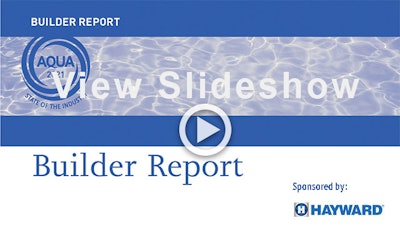Through the 2010s, each year in the pool construction industry was much like the one before, with growth in the low single digits (plus or minus), similar problems and incremental change. Then came 2020.
The pandemic that rocked the world drove unprecedented demand for backyard pools (see graph below), but also ushered in the worst supply problems the industry had ever seen. Consumers were asking for more pool shells, spas, pumps, heaters, filters and all possible types of outdoor living products than ever before, but manufacturers were bedeviled by their own supply and shipping problems, as well as problems due to COVID strictures.
So many things happened at once it's hard to keep track of them all: Builders' costs went up dramatically, but they raised prices to compensate, and then some. Companies completely revamped their systems to deal with the strange new COVID conditions. These might cause a key worker to stay home to monitor kids who were out of school, they might result in a bored, homebound customer reporting on construction crews taking a smoke break, or they might result in a retailer outfitting a mobile water testing van to serve customers no longer willing to travel to the store. There were many strange sights in 2020.
When the dust settled and the calendar flipped to 2021, it had been one of the most financially successful years in the history of the industry.
|
Industry Spotlight: Hayward Pool ProductsThere have been several new advancements in the world of pool heaters recently, specifically with new innovations in fuel line flexibility, breakthroughs in minimal space requirements and the introduction of variable-speed technology to heat pumps. Heater Product Manager Joshua Hoots discusses a few of Hayward's recent leading-edge innovations in efficient, high-performance pool heater technology. AQUA: What's the latest in heater technology from Hayward? Joshua Hoots, Hayward Pool Products: We're excited about the Universal HC Series dual-fuel gas heater, which has the flexibility to run on either natural gas or liquid propane. Changing between the fuel types is done with a simple twist of our easy out mixing orifice. This is a huge benefit for installers and servicers alike. The days of stocking both natural gas and LP heaters are over — any time a seller can cut product SKUs in half, that's a good day. Consumers will like the Universal HC Series' small footprint that can operate with zero wall clearance. Let me say that again, just to let it sink in: zero wall clearance. The novel heat discharge design allows the unit to operate at full capacity right up against a fence, pad wall or another component, making it ideal for small pool pads and tight spaces. Heaters usually take up a lot of real estate, but not this one. That said, don't mistake the smaller footprint for less-than-powerful performance. We like to say that it provides the maximum performance in a minimum footprint, and I think that captures what the Universal HC Series can do quite nicely. There are plenty of features that servicers will love, too — like the quick-access top panel, which lets them access the internal components without needing to crouch or kneel. That feature in particular has gotten a lot of positive feedback from the field. It gives servicers an easy point of access for high-use internal components like the gas shutoff, voltage selection and more. Better still: The top panel is reversible, so it easily swaps plumbing from left to right with a single fastener. All that with one top panel. It's kind of funny how much impact one simple change can have, especially in an area of the product that's been previously overlooked within the industry. AQUA: How does the use of variable-speed technology affect heaters? JH: By now, we're accustomed to talking about variable-speed technology in the context of pool pumps, but it's still a new concept in the heater space. That's what makes the new HeatPro VS variable-speed heat and cool heat pump such a key addition to our heater lineup. The underlying principle of variable-speed heaters is the same as with pumps: let the motor flex its run speed up and down (depending on the current heating needs) to make sure that it's only working as hard as it needs to. If the heater doesn't need to bounce between off and full-blast, it can save a lot of energy in the process. Imagine a car that only runs at full throttle and trying to keep it under the speed limit. You would spend a lot of unnecessary effort pulling your foot off the pedal and putting it back on. It's the same for pumps. Since our variable-speed heat pumps can adjust their output speed based on the pool water and ambient temperature, they can produce significant savings for a pool owner's energy bill. HeatPro VS is also the very first AHRI-certified variable-speed vertical discharge heat pump in North America. That's a lot of words to say that we've totally redesigned the compressor and control system, which allows for better performance. As a result, the heater has soft start operation and the highest partial load COP on the market. For consumers, variable-speed technology offers many exciting benefits. Most notably, it means they can set a desired pool temperature and a designated runtime — and then let the HeatPro VS deliver the optimally efficient heating cycle. An ancillary benefit of variable-speed technology is that the units run significantly quieter, which is always a welcome improvement when it comes to perfecting pool and backyard living. |














































